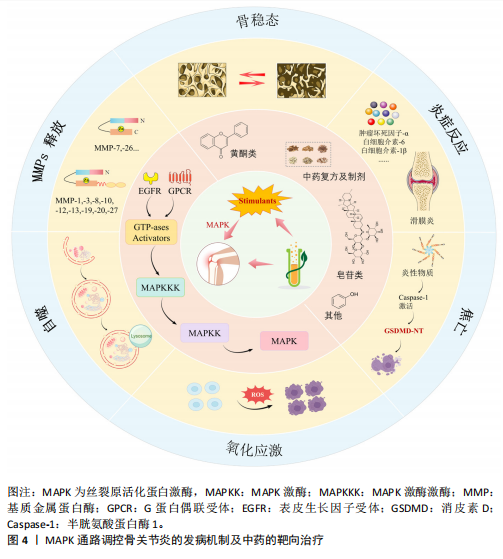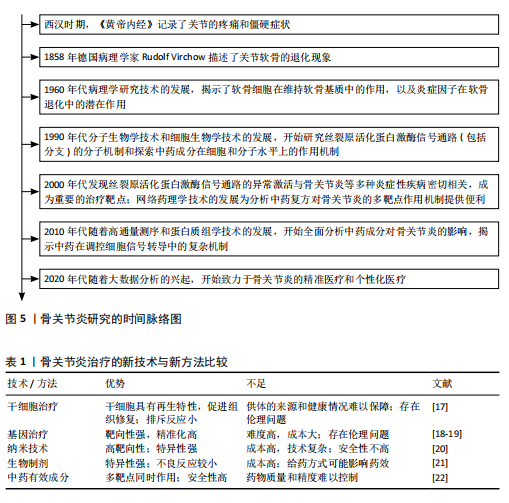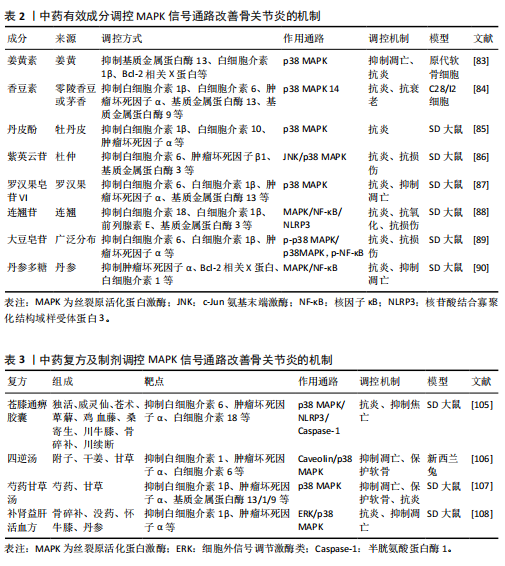[1] MAUTNER K, GOTTSCHALK M, BODEN SD, et al. Cell-based versus corticosteroid injections for knee pain in osteoarthritis: a randomized phase 3 trial. Nat Med. 2023; 29(12):3120-3126.
[2] LI Z, DAI A, YANG M, et al. p38MAPK Signaling Pathway in Osteoarthritis: Pathological and Therapeutic Aspects. J Inflamm Res. 2022;15:723-734.
[3] Allen KD, Thoma LM, Golightly YM. Epidemiology of osteoarthritis. Osteoarthritis Cartilage. 2022;30(2):184-195.
[4] Li H, Kong W, Liang Y, et al. Burden of osteoarthritis in China, 1990-2019: findings from the Global Burden of Disease Study 2019. Clin Rheumatol. 2024;43(3):1189-1197.
[5] Cao F, Xu Z, Li XX, et al. Trends and cross-country inequalities in the global burden of osteoarthritis, 1990-2019: A population-based study. Ageing Res Rev. 2024;99:102382.
[6] Patwardhan V, Gil GF, Arrieta A, et al. Differences across the lifespan between females and males in the top 20 causes of disease burden globally: a systematic analysis of the Global Burden of Disease Study 2021. Lancet Public Health. 2024;9(5):e282-e294.
[7] 刘康妍, 郑聪, 胡海澜. 骨关节炎流行病学研究 [J]. 中华关节外科杂志(电子版), 2017,11(3):320-323.
[8] Hunter DJ, March L, Chew M. Osteoarthritis in 2020 and beyond: a Lancet Commission. Lancet. 2020; 396(10264):1711-1712.
[9] 陈跃平,陈锋,彭清林,等. 三七治疗骨关节炎机制:基于UHPLC-QE-MS、网络药理学及分子动力学模拟 [J]. 中国组织工程研究,2025,29(8):1751-1760.
[10] 宋霞,赵慧,郑涵,等.基于网络药理学和分子对接探究复方丹参滴丸治疗骨关节炎的作用机制[J].中国医药科学,2024, 14(17):30-33.
[11] Wang X, Guo Z, Lin J, et al. Indirubin protects chondrocytes and alleviates OA by inhibiting the MAPK and NF-κB pathways. Int Immunopharmacol. 2023;115:109624.
[12] Li Z, Dai A, Yang M, et al. p38MAPK Signaling Pathway in Osteoarthritis: Pathological and Therapeutic Aspects. J Inflamm Res. 2022;15:723-734.
[13] Wang X, Guo Z, Lin J, et al. Indirubin protects chondrocytes and alleviates OA by inhibiting the MAPK and NF-κB pathways. Int Immunopharmacol. 2023;115:109624.
[14] Davis RJ. Signal transduction by the JNK group of MAP kinases. Cell. 2000;103(2): 239-252.
[15] Roy A, Srivastava M, Saqib U, et al. Potential therapeutic targets for inflammation in toll-like receptor 4 (TLR4)-mediated signaling pathways. Int Immunopharmacol. 2016;40:79-89.
[16] LEE SH, CHOI SH, LEE IS, et al.Anti-inflammatory effect of Rosa laevigata extract on in vitro and in vivo model of allergic asthma via the suppression of IgE and related cytokines.Molecular & Cellular Toxicology. 2020(2):16.
[17] LOO SJQ, WONG NK. Advantages and challenges of stem cell therapy for osteoarthritis (Review). Biomed Rep. 2021; 15(2):67.
[18] UEBELHOER M, LAMBERT C, GRISART J, et al. Interleukins, growth factors, and transcription factors are key targets for gene therapy in osteoarthritis: A scoping review. Front Med (Lausanne). 2023;10:1148623.
[19] LI X, SHEN L, DENG Z, et al. New treatment for osteoarthritis: Gene therapy. Precis Clin Med. 2023;6(2):016.
[20] LAWSON TB, MÄKELÄ JTA, KLEIN T, et al. Nanotechnology and osteoarthritis; part 1: Clinical landscape and opportunities for advanced diagnostics. J Orthop Res. 2021;39(3):465-472.
[21] WEBER AE, BOLIA IK, TRASOLINI NA. Biological strategies for osteoarthritis: from early diagnosis to treatment. Int Orthop. 2021;45(2):335-344.
[22] 金柱,刘高卿,徐文博,等.骨关节炎疼痛机制及相关中药治疗研究进展[J].新乡医学院学报,2024,41(10):996-1000.
[23] SCHIPHOF D, VAN DEN DRIEST JJ, RUNHAAR J. Osteoarthritis year in review 2017: rehabilitation and outcomes. Osteoarthritis Cartilage. 2018;26(3):326-340.
[24] CHARLIER E, DEROYER C, CIREGIA F, et al. Chondrocyte dedifferentiation and osteoarthritis (OA). Biochem Pharmacol. 2019;165:49-65.
[25] KOMORI T. Cell Death in Chondrocytes, Osteoblasts, and Osteocytes. Int J Mol Sci. 2016;17(12):2045.
[26] SHU Z, MIAO X, TANG T, et al. The GSK‑3β/β‑catenin signaling pathway is involved in HMGB1‑induced chondrocyte apoptosis and cartilage matrix degradation. Int J Mol Med. 2020;45(3):769-778.
[27] CHEN CP, LIN YC, PENG YH, et al. Rosmarinic Acid Attenuates the Lipopolysaccharide-Provoked Inflammatory Response of Vascular Smooth Muscle Cell via Inhibition of MAPK/NF-κB Cascade. Pharmaceuticals (Basel). 2022;15(4):437.
[28] WANG X, GUO Z, LIN J, et al. Indirubin protects chondrocytes and alleviates OA by inhibiting the MAPK and NF-κB pathways. Int Immunopharmacol. 2023;115:109624.
[29] 李仪杰,刘亚东,李进敏,等.沉默信息调节因子2相关酶1在骨关节炎中的作用机制[J].风湿病与关节炎,2024, 13(10):58-64.
[30] LIU CL, HO TL, FANG SY, et al. Ugonin L inhibits osteoclast formation and promotes osteoclast apoptosis by inhibiting the MAPK and NF-κB pathways. Biomed Pharmacother. 2023;166:115392.
[31] SHARMA AR, JAGGA S, LEE SS, et al. Interplay between cartilage and subchondral bone contributing to pathogenesis of osteoarthritis. Int J Mol Sci. 2013;14(10):19805-19830.
[32] SONDERGAARD BC, SCHULTZ N, MADSEN SH, et al. MAPKs are essential upstream signaling pathways in proteolytic cartilage degradation--divergence in pathways leading to aggrecanase and MMP-mediated articular cartilage degradation. Osteoarthritis Cartilage. 2010;18(3): 279-288.
[33] PRASADAM I, FRIIS T, SHI W, et al. Osteoarthritic cartilage chondrocytes alter subchondral bone osteoblast differentiation via MAPK signalling pathway involving ERK1/2. Bone. 2010;46(1):226-235.
[34] ZHOU Z, TANG S, NIE X, et al. Osteoarthritic infrapatellar fat pad aggravates cartilage degradation via activation of p38MAPK and ERK1/2 pathways. Inflamm Res. 2021; 70(10-12):1129-1139.
[35] DENNY WA. Inhibitors and Activators of the p38 Mitogen-Activated MAP Kinase (MAPK) Family as Drugs to Treat Cancer and Inflammation. Curr Cancer Drug Targets. 2022;22(3):209-220.
[36] NEOGI T, GUERMAZI A, ROEMER F, et al. Association of Joint Inflammation With Pain Sensitization in Knee Osteoarthritis: The Multicenter Osteoarthritis Study. Arthritis Rheumatol. 2016;68(3):654-661.
[37] MATHIESSEN A, CONAGHAN PG. Synovitis in osteoarthritis: current understanding with therapeutic implications. Arthritis Res Ther. 2017;19(1):18.
[38] LIAO CR, WANG SN, ZHU SY, et al. Advanced oxidation protein products increase TNF-α and IL-1β expression in chondrocytes via NADPH oxidase 4 and accelerate cartilage degeneration in osteoarthritis progression. Redox Biol. 2020;28:101306.
[39] MNICH SJ, BLANNER PM, HU LG, et al. Critical role for apoptosis signal-regulating kinase 1 in the development of inflammatory K/BxN serum-induced arthritis. Int Immunopharmacol. 2010; 10(10):1170-1176.
[40] ZÚÑIGA-MUÑOZ A, GARCÍA-NIÑO WR, CARBÓ R, et al. The regulation of protein acetylation influences the redox homeostasis to protect the heart. Life Sci. 2021;277:119599.
[41] ABRAMOFF B, CALDERA FE. Osteoarthritis: Pathology, Diagnosis, and Treatment Options. Med Clin North Am. 2020;104(2): 293-311.
[42] HSUEH MF, ZHANG X, WELLMAN SS, et al. Synergistic Roles of Macrophages and Neutrophils in Osteoarthritis Progression. Arthritis Rheumatol. 2021;73(1):89-99.
[43] BORTHWICK LA. The IL-1 cytokine family and its role in inflammation and fibrosis in the lung. Semin Immunopathol. 2016; 38(4):517-534.
[44] FIELDS JK, GÜNTHER S, SUNDBERG EJ. Structural Basis of IL-1 Family Cytokine Signaling. Front Immunol. 2019;10:1412.
[45] AKHTER S, TASNIM FM, ISLAM MN, et al. Role of Th17 and IL-17 Cytokines on Inflammatory and Auto-immune Diseases. Curr Pharm Des. 2023;29(26):2078-2090.
[46] HUANG F, WONG P, LI J, et al. Osteoimmunology: The correlation between osteoclasts and the Th17/Treg balance in osteoporosis. J Cell Mol Med. 2022;26(13):3591-3597.
[47] FANG Y, TIAN S, PAN Y, et al. Pyroptosis: A new frontier in cancer. Biomed Pharmacother. 2020;121:109595.
[48] JIANG N, AN J, YANG K, et al. NLRP3 Inflammasome: A New Target for Prevention and Control of Osteoporosis?. Front Endocrinol (Lausanne). 2021;12:752546.
[49] WANG F, XIAO J, LI M, et al. Picroside II suppresses chondrocyte pyroptosis through MAPK/NF-κB/NLRP3 signaling pathway alleviates osteoarthritis. PLoS One. 2024;19(8):e0308731.
[50] ZHOU F, HAN X, WANG L, et al. Associations of osteoclastogenesis and nerve growth in subchondral bone marrow lesions with clinical symptoms in knee osteoarthritis. J Orthop Translat. 2021;32:69-76.
[51] LI Z, DAI A, YANG M, et al. p38MAPK Signaling Pathway in Osteoarthritis: Pathological and Therapeutic Aspects. J Inflamm Res. 2022;15:723-734.
[52] JIANG T, GONG Y, ZHANG W, et al. PD0325901, an ERK inhibitor, attenuates RANKL-induced osteoclast formation and mitigates cartilage inflammation by inhibiting the NF-κB and MAPK pathways. Bioorg Chem. 2023;132:106321.
[53] SAHA S, PANIGRAHI DP, PATIL S, et al. Autophagy in health and disease: A comprehensive review. Biomed Pharmacother. 2018;104:485-495.
[54] LEVINE B, KROEMER G. Biological Functions of Autophagy Genes: A Disease Perspective. Cell. 2019;176(1-2):11-42.
[55] LI YS, ZHANG FJ, ZENG C, et al. Autophagy in osteoarthritis. Joint Bone Spine. 2016; 83(2):143-148.
[56] DUAN R, XIE H, LIU ZZ. The Role of Autophagy in Osteoarthritis. Front Cell Dev Biol. 2020;8:608388.
[57] LAN CN, CAI WJ, SHI J, et al. MAPK inhibitors protect against early‑stage osteoarthritis by activating autophagy. Mol Med Rep. 2021;24(6):829.
[58] EBRAHIMI S, ALALIKHAN A, AGHAEE-BAKHTIARI SH, et al. The redox modulatory effects of SP/NK1R system: Implications for oxidative stress-associated disorders. Life Sci. 2022;296:120448.
[59] PASOLD J, ZANDER K, HESKAMP B, et al. Positive impact of IGF-1-coupled nanoparticles on the differentiation potential of human chondrocytes cultured on collagen scaffolds. Int J Nanomedicine. 2015;10:1131-1143.
[60] LIU L, LUO P, YANG M, et al. The role of oxidative stress in the development of knee osteoarthritis: A comprehensive research review. Front Mol Biosci. 2022;9:1001212.
[61] 李琳慧,何阳梅,周志刚,等.基于NGF/p38 MAPK/TRPV1信号通路探讨热敏灸治疗膝骨关节炎的外周敏化效应机制[J].中华中医药杂志,2022,37(3):1379-1383.
[62] 孙晓娟,侯娜.丹参酮对膝骨关节炎大鼠的抗炎作用[J].现代食品科技,2019, 35(12):14-19+86.
[63] JIA PT, ZHANG XL, ZUO HN, et al. Articular cartilage degradation is prevented by tanshinone IIA through inhibiting apoptosis and the expression of inflammatory cytokines. Mol Med Rep. 2017;16(5):6285-6289.
[64] 李瑞英,李杰.丹参酮ⅡA磺酸钠联合常规西药治疗不稳定型心绞痛患者的效果[J].中国药物滥用防治杂志,2024, 30(10):1920-1923.
[65] 童伍岳,张智辉,叶国庆,等.基于PI3K/Akt信号通路探讨中医药治疗股骨头坏死的研究进展[J].中国医药导报,2024, 21(30):45-49+54.
[66] YU Y, KIM SM, PARK K, et al. Therapeutic Nanodiamonds Containing Icariin Ameliorate the Progression of Osteoarthritis in Rats. Int J Mol Sci. 2023;24(21):15977.
[67] LUO Z, DONG J, WU J. Impact of Icariin and its derivatives on inflammatory diseases and relevant signaling pathways. Int Immunopharmacol. 2022;108:108861.
[68] 王照宇,赵国栋,刘佳,等.中药调控cAMP/PKA/CREB信号通路改善轻度认知障碍研究进展[J/OL].中医学报,1-10[2025-01-17].http://kns.cnki.net/kcms/detail/41.1411.R.20241128.0946.004.html.
[69] ZHANG J, WU C, GAO L, et al. Astragaloside IV derived from Astragalus membranaceus: A research review on the pharmacological effects. Adv Pharmacol. 2020;87:89-112.
[70] MA Z, PIAO T, WANG Y, et al. Astragalin inhibits IL-1β-induced inflammatory mediators production in human osteoarthritis chondrocyte by inhibiting NF-κB and MAPK activation. Int Immunopharmacol. 2015;25(1):83-87.
[71] 于倩,巫冠中.木犀草素抗炎机制的研究进展[J].药学研究,2019,38(2):108-111+119.
[72] 曾克非,夏婷婷,吴小兰,等.木犀草素通过TLR4/PI3K/AKT通路对子痫前期大鼠胎盘血管生成及细胞凋亡的影响[J].中国免疫学杂志,2024,40(2):330-336.
[73] PETER WF, SWART NM, MEERHOFF GA, et al. Clinical Practice Guideline for Physical Therapist Management of People With Rheumatoid Arthritis. Phys Ther. 2021; 101(8):127.
[74] LIAO PC, LAI MH, HSU KP, et al. Identification of β-Sitosterol as in Vitro Anti-Inflammatory Constituent in Moringa oleifera. J Agric Food Chem. 2018;66(41):10748-10759.
[75] 宋吉美,房国伟,朱建德,等.柴胡有效成分及其类方治疗桥本甲状腺炎作用机制研究进展[J].山西中医,2020,36(10): 57-59+62.
[76] 范晓阳,贾世艳,司瑞花,等.Box-Behnken响应面法优化穿山龙总皂苷的提取工艺及体外抗氧化活性研究[J].中医药信息, 2022,39(9):26-32.
[77] CHEN YH, LUO R, LEI SS, et al. Anti-inflammatory effect of Ganluyin, a Chinese classic prescription, in chronic pharyngitis rat model. BMC Complement Med Ther. 2020;20(1):265.
[78] ZHOU Q, SUN HJ, ZHANG XW. Total Saponin Fraction of Dioscorea Nipponica Makino Improves Gouty Arthritis Symptoms in Rats via M1/M2 Polarization of Monocytes and Macrophages Mediated by Arachidonic Acid Signaling. Chin J Integr Med. 2023; 29(11):1007-1017.
[79] 周强,栗占国.白芍总苷的药理作用及其在自身免疫性疾病中的应用[J].中国新药与临床杂志,2003,22(11):687-691.
[80] 陈谱,阮安民,周俊,等.白芍总苷对骨关节炎软骨细胞炎症及退变的影响[J].中国组织工程研究,2021,25(29):4614-4618.
[81] 杜旭召,杨豪,邓素玲,等.白芍总苷对骨关节炎软骨细胞增殖及分泌表达的影响[J].中国骨质疏松杂志,2016,22(11): 1375-1379+1385.
[82] 董良杰,王勤俭,王单一,等.白芍总苷对人骨关节炎软骨细胞增殖及p38MAPK蛋白表达的影响[J].郑州大学学报(医学版),2019,54(3):431-435.
[83] 宋飞,范学菲,刘楠楠,等.姜黄素通过调控DUSP1/p38 MAPK通路减轻IL-1β诱导的软骨细胞损伤[J].安徽医科大学学报,2024,59(11):1903-1910.
[84] 刘恺文,叶元兰,郭风劲.香豆素调控SASP抑制细胞衰老缓解骨关节炎的试验研究[J].重庆医科大学学报,2024,49(12): 1556-1565.
[85] 杨小四,姚文兵,胡华麟,等.丹皮酚对佐剂性关节炎大鼠继发性炎症的作用[J].中成药,2022,44(9):3000-3004.
[86] 杨博辰,付学敬,朱琳.紫云英苷对膝关节骨性关节炎大鼠JNK/p38 MAPK信号通路的影响[J].中国骨质疏松杂志,2022, 28(10):1491-1495+1500.
[87] 曾智,李浩,王晓旭,等.罗汉果皂苷Ⅵ对膝骨关节炎大鼠模型的治疗作用及其机制探讨[J].免疫学杂志,2022,38(9): 804-809.
[88] 王海滨,李平,张志刚,等.连翘苷调节MAPK/NF-κB/NLRP3信号通路对膝骨性关节炎大鼠软骨损伤的影响[J].国际检验医学杂志,2023,44(15):1902-1907.
[89] 张超,张锐,王冶,等.大豆皂苷缓解骨关节炎模型大鼠软骨损伤和关节炎症的机制[J].免疫学杂志,2023,39(3):225-232.
[90] 张扬,张宁,玄锋学,等.丹参多糖对碘乙酸钠所致大鼠膝骨性关节炎的治疗作用及机制研究[J].天然产物研究与开发, 2024,36(11):1821-1829.
[91] 梁霄,李娅兰,张筠昊,等.基于TLR2/p38 MAPK/NF-κB信号通路探讨独活寄生汤对类风湿性关节炎大鼠的抗炎作用及机制[J].中国实验方剂学杂志,2023, 29(11):43-52.
[92] 吴广文,刘淑如,陈俊,等.独活寄生汤治疗膝骨关节炎的作用机制[J].中国组织工程研究,2019,23(19):2965-2971.
[93] LIN W, SHEN P, HUANG Y, et al. Wutou decoction attenuates the synovial inflammation of collagen-induced arthritis rats via regulating macrophage M1/M2 type polarization. J Ethnopharmacol. 2023; 301:115802.
[94] 付长龙.乌头汤延缓膝骨关节炎大鼠软骨退变的作用与机制研究[D].福州:福建中医药大学,2019.
[95] YAN BZ, LUO D, LI JC, et al. Molecular mechanism of Wutou Decoction in the treatment of osteoarthritis: a bioinformatics and molecular docking study. Ann Palliat Med. 2021;10(7):7706-7720.
[96] 宋玉成,欧国谊,杨永强,等.补肾通络方治疗膝骨性关节炎机制网络药理学研究[J].中国药业,2023,32(24):61-64.
[97] 尤银刚,魏秋芳,滕月鹏,等.补肾通络方对膝骨关节炎大鼠软骨损伤、氧化应激及TGF-β/SMAD2信号通路的影响[J].北方药学,2023,20(12):5-11.
[98] 刘学睿,李兴勇,唐兆鹏,等.中药复方调控氧化应激防治骨关节炎研究进展[J].中国骨质疏松杂志,2024,30(12):1820-1825.
[99] 张学哲.经方、时方治疗癌痛的理法方药规律及机制探析[D].沈阳:辽宁中医药大学,2021.
[100] 崔海舰.身痛逐瘀汤治疗腰椎间盘突出症临床研究及延缓椎间盘退变实验研究[D].沈阳:辽宁中医药大学,2024.
[101] 陈子前,马太平,刁虹.身痛逐瘀汤加减联合推拿治疗骨性膝关节炎的疗效及对IL-1和TNF的影响[J].四川中医, 2016,34(8):152-154.
[102] 田惠萍,夏娟,陈盼,等.汤小虎教授运用桂枝类方治疗骨关节炎经验总结[J].云南中医中药杂志,2017,38(11):8-11.
[103] 黄逸唯,朱玲,卢梓铤,等.基于网络药理学及分子对接的补中益气汤“异病同治”慢性尿路感染、肾性血尿和肾性蛋白尿的作用机制[J].中国医院用药评价与分析,2024,24(10):1190-1195.
[104] 于冬冬,李鑫,乔隆.补中益气汤对膝骨关节炎大鼠膝关节及IL-6、VEGFA的影响[J].中华中医药杂志,2022,37(12):7369-7373.
[105] 张志猛,袁道通,靳希民,等.苍膝通痹胶囊调控p38 MAPK/NLRP3/Caspase-1通路介导膝关节骨性关节炎软骨细胞焦亡的机制[J].中国实验方剂学杂志,2024, 30(22):61-68.
[106] 魏文元,王亭,王鹏,等.四逆汤饼灸对兔膝骨关节炎软骨中Caveolin-1/p38 MAPK信号通路蛋白表达的影响[J].宁夏医科大学学报,2024,46(3):259-264+280.
[107] 宋庆慧,李秋月,杨丽平,等.基于免疫印迹实验验证芍药甘草汤治疗骨关节炎关键靶点和通路[J].辽宁中医药大学学报,2022,24(9):10-13.
[108] 许骏,谢林.补肾益肝活血方含药血清对ERK/p38MAPK信号通路的影响[J].中国老年学杂志,2019,39(18):4535-4540.
|


